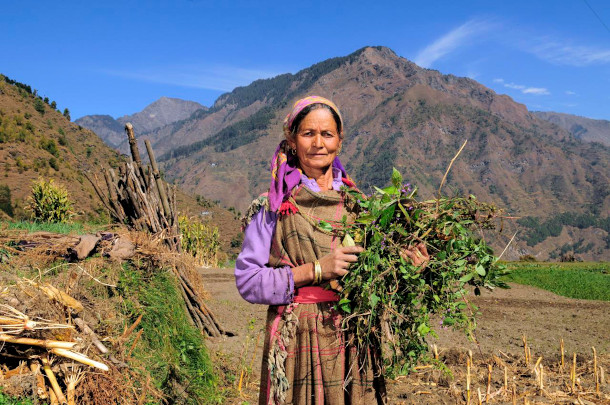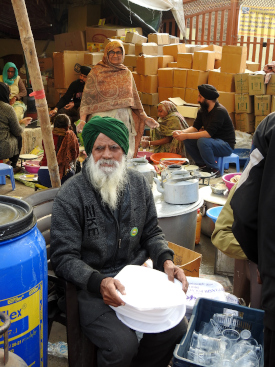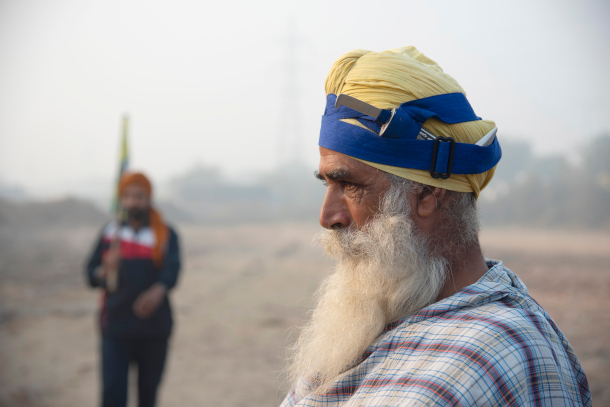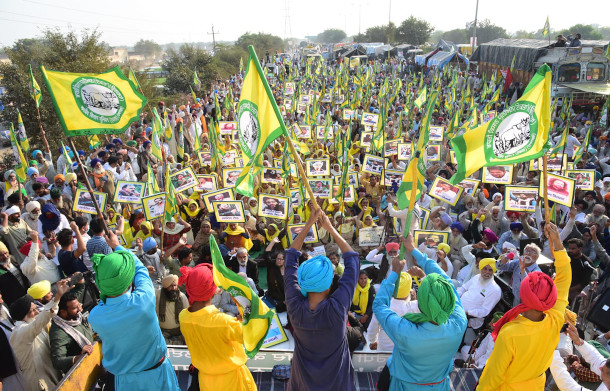India’s Farm Crisis and the Climate Emergency
Air Date: Week of February 12, 2021

According to Oxfam India more than 75% of rural women in India who work full time are farmers but less than 13% of them own the land they till. Women have been a powerhouse throughout the protests, holding fort and cooking all in hopes in securing their jobs and land for future generations. (Photo: Niel Palmer, CIAT, Flickr, CC BY-SA 2.0)
India is experiencing dramatic climate impacts, with both increased flooding and drought. Farmers throughout the country have been struggling to survive, and in September 2020 the Indian government passed legislation that thousands of farmers have gone on strike against, fearing they won’t get a fair price for their crops. Omair Ahmad, the South Asia editor for The Third Pole joins Host Bobby Bascomb to talk about Indian farmers’ protests and how the climate crisis is changing agriculture in India.
Transcript
CURWOOD: From PRX and the Jennifer and Ted Stanley Studios at the University of Massachusetts Boston, this is Living on Earth. I’m Steve Curwood.
BASCOMB: And I’m Bobby Bascomb. India is home to more than 1.3 billion people and more than half of them make their living from farming. Massive farmer led protests and strikes erupted in India recently when the government announced new laws that farmers say would add an additional burden to their industry already struggling in the face of widespread droughts and floods.
[PROTEST SOUNDS]
BASCOMB: Millions of farmers and their allies have flooded into major cities over the last few months to block roadways in protest. The Indian government has used tear gas to try to break up the demonstrations and at least one person has died. We’ll get into the new controversial laws in a moment but the struggle for Indian farmers started way before these protests. Climate change has dramatically altered the monsoon season that farmers rely on for water, forcing many to abandon farming all together. For more I’m joined now by Omair Ahmad, the South Asia editor for The Third Pole.
Omair welcome to Living on Earth!
AHMAD: Thank you for having me.
BASCOMB: I understand that climate change is taking a toll on farming there, the monsoon rains have changed. They're shorter and more intense followed by months of drought. Can you tell us more about that and how it's affected agriculture in India.
AHMAD: So, floods and droughts are the clearest indicator of climate change, right? And it's as explained by scientist, the hotter the air is, the more water it will hold. As the air heats up, it's takes more water for terrain. And when it rains, it does a lot more in a shorter time span. So that basically means you've got longer periods of dry spells and shorter periods of intense rainfall, the soil gets washed away with the intense rainfall. So you've got flooding, because for 1000s of years, you've been doing agriculture based on these rainfall patterns. And about 80% of rainfall in India comes within the four to five months of the monsoon period. And that is intensely important for agriculture. Now, that pattern is now being disrupted more and more. So you're not getting the long cycles necessary to grow a crop to its full potential. And even when it grows, sometimes what happens is floods come. Soo the untimely rain is hitting crops when they're standing when you've just harvested them, so that ends up causing a lot of loss and damage to ready crops. In areas where you have irrigation, what people do is try to pump up water to compensate for water that doesn't come at the right time. And then you put in a lot more fertilizer, to make sure that the crop grows up in the shorter time period that you have to its full capacity. At the same time, you also dump in more pesticides, because with climate change, you've got a lot more new pests coming in. And you want to make sure that you're defending the crop that you grow. And this has been going on now for the last few decades, this crisis led to climate change.

More than 250 million people across India joined the farmers' protests. Thousands of farmers have set up camp outside India’s “breadbasket”, New Delhi to protest against 3 farm bills that would further imperil farmers' survival. (Photo: Harvinder Chandigarh, Wikimedia Commons, CC BY-SA 4.0)
BASCOMB: So how are farmers dealing with it? I mean, it sounds like a really difficult situation for them.
AHMAD: So there's two sets. So there's the farmers without access to irrigation, which is about half of them. And how they're dealing with this is with great difficulty is the answer. Because if the drought hits, and you don't have alternative means of irrigation, there's only a certain amount of water you can pull out of well by yourself and put onto a field. And what that has led to is huge amounts of migration out of these farmlands to people coming to urban areas. Now these are skilled farmers, that's what their skill set is. But in urban areas, all that they have to sell is unskilled labor. So they tend to be incredibly badly exploited in the labor market. And because when droughts happen, so many people are on the labor market, they can negotiate any decent contracts. So right now I am in Delhi, and there are workmen working on a building just across the block. And these are people who earn about 400 rupees a day, that would be about $5 to $6. And the women who working on on these construction sites are earning about 200 rupees a day, that’s $3. And so people would, with an irrigated fields are largely just forced to sell their labor at very low prices. And it's largely male labor that migrates because it's much harder for women to migrate they face much more dangerous.
BASCOMB: This really sounds like a crisis on a lot of levels, a humanitarian crisis of people that can no longer make a living and are moving to the cities and maybe being exploited and also a food security crisis. What do you make of that?
AHMAD: So yeah, food security is a huge issue for India. And this is something like almost a recurring issue in the sense that when India became independent, it didn't grow enough food to support its population and so food aid became a huge part of the Cold War involving India and the US and the Soviet Union. And because India didn't want to be involved in the Cold War, it wanted to be non aligned in the 60s, it boosted what it called its Green Revolution to try to get food secure. The Green Revolution, basically narrowed down the amount of crops that we would grow. But it did it using a lot more water than we used to, and a lot more fertilizer than we used to. So India now grows, actually enough crops to feed itself and more. And when we were able to feed ourselves, we set in the public distribution system. So for people earning less than 70 cents a day, you have a below poverty line card, and you can go to a public distribution shop and get green at lower than market rate. The problem is multifold. One is there's lots of corruption when it comes to people making a bit of a quick buck between how much they're supposed to sell and how they are. Secondly, the public distribution system is very expensive and so you're, you're accruing all of these crops. Thirdly, and most importantly, because the Green Revolution was focused on using lots of water and lots of fertilizer and growing only a certain set of crops, we have been growing in a lot of areas, crops that are not suitable to the climate, using too much water and therefore driving down groundwater and polluting the land with excess fertilizer.

About 70% of rural households in India depend on urban agriculture for sustenance and about 60% of farming depends on rain-fed irrigation. (Photo: Randeep Maddoke, Wikimedia Commons, Public Domain)
BASCOMB: And now I understand that Indian farmers are protesting some new laws recently passed by the government. And these are serious protests. 10s of 1000s of farmers at sites across the country are blocking roadways blocking traffic, can you tell me about these new laws? And why are farmers so angry?
AHMAD: So we've got our MSP regime, this is the minimum support price regime. So the government guarantees that it will buy crops at a minimum price, setting a floor to how low a price can be. What they're afraid of is that with all of these laws coming in, that the government as a larger buyer is going to disappear from the market, they will be left in no position to really negotiate with large corporate buyers, and will have to sell at prices that buyers negotiate them too. And worst of all, what they're afraid of is that there won't be a guaranteed sell of their produce. So this has happened, unfortunately, with contract farming in India is that is it already exists. And that large private agro buyers have at times reneged on the contract, right. Or have said, basically, that what you're giving us is not up to our quality, and therefore we won't buy. And so you have a problem with the small farmer who's spent months growing this crop, and he suddenly doesn't have a buyer, right. And often it's women growing the crop, women are at least 50% of the workforce, often an underpaid workforce. But the person selling the owner of the fields will tend to be a man so at the end of the day, it's he selling. But a small farmer spends months growing these crops at the end of the day wants a certain guarantee of a buyer at a decent price. And farmers are now afraid that that's what the government is undermining in a bid to privatized large parts of farming.
BASCOMB: So why would the government want to make these changes? It sounds like they're prioritizing larger, more industrial farmers over the small scale farmers. Why does the government want to make these changes to begin with?
AHMAD: Well, large agro corporations can invest in large infrastructure. They can invest in silos, they can invest in storage facilities, they can invest in cold storage, they can invest in processing plants and all of these may in the end raise the amount of money that you can get from the crop. The challenge is, there is nothing in these laws that tells us that the farmer at the bottom will benefit that you will, may get more money out of these crops, but it's entirely at the mercy of the large corporations whether they will pay farmers more or less than they would earn earlier. And history kind of tells us that trickle down economics doesn't really work that well.
BASCOMB: You know, scientists tell us to expect all of these calamities with climate change, and regular weather patterns and poverty and migration and and all of these things, they always seem still in the future still decades off in the future, but from what you're telling us, it's now in India.

Protesters and reporters in India have been met with tear gas and opposition from the government. To date government leaders have failed to compromise with farmers and the more than 30 farm unions that support them despite months of talks. (Photo: Randeep Maddoke, CCO, Wikimedia Commons)
AHMAD: Yes. And that's something that I think a lot of people don't realize is that the climate crisis is already upon us, we're actually already living through it. If you're buffered from the environment to a certain degree, right? I mean, if you don't depend on rainfall or regular rainfall or regular, irregular patterns of rainfall, then you can kind of ignore it. If the food you buy is what you buy in the supermarket, rather than food you raise, then you don't see the impacts immediately. If you are not dependent on springs in the mountains, to grow your crop or to bring water to your house, it doesn't really matter that those springs are disappearing. But for developing countries especially, you are much more dependent on your environment. You are, in a sense much more connected to your environment so a small failure in your environment doesn't leave you with any backup.
BASCOMB: Omair Ahmad is the South Asia editor for Third Pole. Thank you so much for taking the time with me today.
AHMAD: Thank you for having me, Bobby.
Links
BBC | “India Farmer Protests: How Rural Incomes Have Struggled to Keep Up”
EcoWatch | “The Ecological Root of India’s Farming Crisis”
The Wire | “The Climate Crisis Is The Foundation Of The Indian Farmers’ Protest”
Living on Earth wants to hear from you!
Living on Earth
62 Calef Highway, Suite 212
Lee, NH 03861
Telephone: 617-287-4121
E-mail: comments@loe.org
Newsletter [Click here]
Donate to Living on Earth!
Living on Earth is an independent media program and relies entirely on contributions from listeners and institutions supporting public service. Please donate now to preserve an independent environmental voice.
NewsletterLiving on Earth offers a weekly delivery of the show's rundown to your mailbox. Sign up for our newsletter today!
 Sailors For The Sea: Be the change you want to sea.
Sailors For The Sea: Be the change you want to sea.
 The Grantham Foundation for the Protection of the Environment: Committed to protecting and improving the health of the global environment.
The Grantham Foundation for the Protection of the Environment: Committed to protecting and improving the health of the global environment.
 Contribute to Living on Earth and receive, as our gift to you, an archival print of one of Mark Seth Lender's extraordinary wildlife photographs. Follow the link to see Mark's current collection of photographs.
Contribute to Living on Earth and receive, as our gift to you, an archival print of one of Mark Seth Lender's extraordinary wildlife photographs. Follow the link to see Mark's current collection of photographs.
 Buy a signed copy of Mark Seth Lender's book Smeagull the Seagull & support Living on Earth
Buy a signed copy of Mark Seth Lender's book Smeagull the Seagull & support Living on Earth

